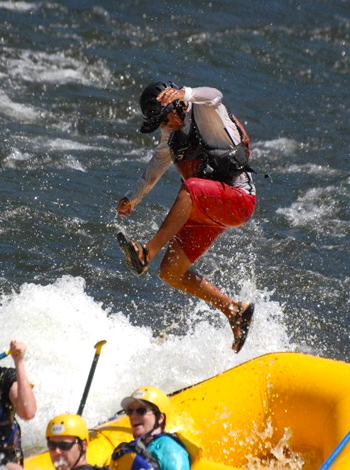Vail rafting is an exciting and adventurous Colorado activity to do during the summer months. Each rafting trip begins when Timberline Tours picks you up from your local accommodation, or at the boathouse, where you will get fully outfitted with rafting gear. Also at the boathouse, Timberline’s expert guides will go through a safety talk that covers key rafting safety topics before you go out to experience the river.

Rafting safety is an essential part of any enjoyable trip, and you will get tips and advice on topics ranging from whitewater rafting dangers to rescue techniques, paddling tips, and more. When someone goes overboard into whitewater rapids, the guide and those in the boat will be instructed to yell out, “Swimmer!” Due to potential hazards in the water, and to the coldness of the water on many stretches of river, swimmer rescue needs to happen quickly. Pay close attention to your guide’s rescue instructions during the safety talk, and ask questions then if you have them. And when you’re out on the river, also listen attentively to your guide’s instructions to make sure that all swimmers in your group are rescued safely and quickly.
While several rescue methods may be at play once swimmers are in the water outside of a raft, self-rescue is the fastest and most effective way to get yourself out of harm’s way. Here’s how it works:
Whitewater Rafting Self-Rescue
The first step of a swimmer’s successful whitewater rafting self-rescue is getting in the whitewater float position. The whitewater float position is a defensive position in which a swimmer moves in the water to float on his or her back with arms outstretched, feet up, and feet facing downstream. Once in the whitewater float position, be sure to keep face and toes out of the water. The whitewater float position allows swimmers to get oriented for optimal situational awareness and push off of any river obstacles that may get in the way. The whitewater float position also minimizes the risk of foot entrapment, which can happen if a foot gets trapped dangerously beneath a rock or other river obstacle.

Next, after taking a brief moment to gain situational cues about your surroundings while in the whitewater float position, transition quickly to a swimming position. Roll over while maintaining a flat profile on the surface of the water, and then aggressively swim to the location where your guide is directing you, either back to the raft, toward a throw rope, or to the shore. The key to whitewater swimming is to swim aggressively, putting quick and sustained effort into swimming with the full body. Swim like you mean it: pull hard with your arms, and put full strength into kicking your legs to reach the desired location as fast as possible.
Rafting 101: Learn More
Timberline Tours focuses on Rafting 101 and Vail rafting safety topics because we want all of our guests to have the best—and safest—Vail rafting experience possible. Find out more here:
–How to Wear Life Jackets
–Whitewater Rafting Safety
–Common Paddling Commands
–Vail Rafting Paddling Tips
–River Rafting Class Ratings Explained
–What to Wear Vail Rafting
CONTACT TIMBERLINE TOURS TODAY
Timberline Tours is the Vail-area’s premier whitewater rafting and backcountry jeep tours outfitter, also offering stand up paddle board (SUP) and duckie river trips on Colorado’s Eagle, Colorado, and Arkansas Rivers. All of our guided trips are open to Vail, Colorado visitors, locals, families, and corporate groups.
To book your Vail, Colorado adventure, call Timberline Tours at (970) 476-1414, or email us at info@timberlinetours.com.
